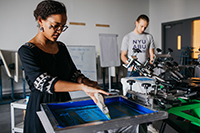-
Academics
-
Admissions
 Your journey to NYUAD starts here. Attend an application workshop or information session.Admissions Events
Your journey to NYUAD starts here. Attend an application workshop or information session.Admissions Events -
Research
-
Campus Life
 Live the possibilities. Be part of a dynamic community of students from over 115 countries.Take a Tour
Live the possibilities. Be part of a dynamic community of students from over 115 countries.Take a Tour - Public Programs
-
About
Exceptional education. World class research. Community-driven.Our Story
- News
- Events
- Social Media Directory
- Press Room
-
- Faculty
- Current Students
- Alumni
- عربي
Mother Nature's Untapped Healing Potential
Natural product research is seeing a renaissance.
Many of the drugs approved by the US Food and Drug Administration over the past 50 years have come from natural products.
These include antibiotics and cancer drugs that have saved or improved the lives of countless people. For the past few decades, however, the rate at which drugs derived from nature that have been approved has slowed. But researchers at NYU Abu Dhabi are again looking to nature to find potential treatments and to better understand fundamental biological processes that relate to human health.
Kristin Gunsalus leads a lab that has been active in the emirate since the NYU Abu Dhabi opened in 2010. When Gunsalus launched the lab, she decided she wanted to explore how microbes that live in the unique environment of the region could be used to produce drug treatments. Gunsalus is co-director of the NYU Abu Dhabi Center for Genomics and Systems Biology, director of bioinformatics, an affiliated faculty of science at NYU Abu Dhabi, and associate professor of biology at NYU New York.
“Micro-organisms communicate with chemicals because they don’t have eyes and ears,” Gunsalus explained, “and most of the FDA approved drugs in the past few decades have come from or are inspired by natural products, and many derive directly from microbes.”
If you can target a disease or a parasite from multiple directions at once using different mechanisms, you can decrease the chance that drug resistance is developed.
“We started isolating bacteria from different areas in the region and started growing them up in our lab, and we developed assays to look at their activity on different kinds of organisms,” Gunsalus said. “A promising approach we are developing is called high-content screening, in which we monitor many aspects of cellular function at the same time, increasing our chances of detecting molecules with a range of effects.”
In one particular project, she and her team studied how chemicals derived from microbes can be used to kill a type of parasitic worm called a nematode.
“These parasites infect about a billion people each year and cause a huge amount of damage to livestock and crops,” she said. “Plant parasites sap the energy of crops, which leads to reduced yields.” Her team has developed some promising results for compounds that are effective in killing nematodes that infect plants, and they are exploring how they might bring these chemicals to market.
Going forward, Gunsalus hopes to use the technology and methods she has developed at NYU Abu Dhabi to study the impact of drug combinations, or “cocktails,” to fight diseases like cancer.
This combinatorial technique holds great promise: “If you can target a disease or a parasite from multiple directions at once using different mechanisms, you can decrease the chance that drug resistance is developed,” she said. “We’d like to identify good combinatorial drug targets, because if you can identify drugs that synergize with each other, you can deliver all of them at a much lower dose than is required to achieve efficacy than with one drug alone.”
Associate Professor of Chemistry Timothy Dore’s research is concerned with understanding interactions between molecules and determining the mechanism of action of complex biological and chemical processes that underlie cancer, seizure disorders, and drug addiction. To do this, Dore’s lab has developed a number of new technologies that drive innovative research in his lab and in others.
“We try to develop technologies that allow people to ask questions they couldn’t ask before."
He describes it as a kind of “laddering effect,” where the development of a particular technology allows researchers to examine a biological or chemical process, and the knowledge that is gained from that research spurs the evolution of a new tool. “The development of these technologies is leading me as a chemist to be able to ask far more complicated questions than I could before,” he said.
One of Dore’s specific research areas is the study of an enzyme, called Ras converting enzyme. Ras is a protein that is often implicated in incidences of cancer, and Dore is studying the function of Ras converting enzyme and its impact on Ras regulation in cancer. To do this work, his lab uses computational and biological screening and synthetic chemistry to create small molecule inhibitors of the enzyme.
“Ras has become such an important target for cancer therapies, and there has been a lot of work on Ras signaling downstream,” and the way it induces the growth of tumors, Dore explained. “But I think that there is a lot going on upstream related to Ras, and there are important questions to be answered in the regulation of Ras and its larger family of proteins.”
Natural product research went out of focus for 10 or 20 years, but it’s seeing a renaissance at the moment.
Assistant Professor of Chemistry Alan Healy, whose research is focused on natural product drug discovery, explains that one of the reasons natural products are so useful is because they are structurally complex from a chemical perspective. “Their diverse 3D structures are often coupled with selective and potent biological activity through their interaction with macromolecules like proteins and DNA,” he said. “Natural product research went out of focus for 10 or 20 years, but it’s seeing a renaissance at the moment due to technological and conceptual advances.”
One innovation is the rapid reduction in cost and time it now takes to sequence a genome. Recent research using this technique has shown that natural products that are isolated by traditional methods in the laboratory represent only a small fraction of what is predicted to exist in nature, Healy explained.
For example, it’s been estimated that less than 10 percent of small molecules that bacteria make have been isolated in the lab, which is an important insight, as these molecules have proven to be a rich source for new pharmaceuticals. “If we can tap into the greater 90 percent that haven’t been isolated, we may find a wealth of potential drug molecules and chemical tools that can be used to perturb diverse cellular pathways,” Healy said.
A major challenge to accessing these molecules is that the vast majority of bacteria cannot be cultured in the lab environment.
Another is recreating the complexity bacteria experience in their natural habitat, which triggers them to produce these molecules, either for defense or nutrient acquisition. Research groups are developing innovative techniques to induce the microbes to generate a wider range of molecules — but isolation and biological investigation of these molecules remains a lengthy and challenging process.
Healy is developing a synthetic process to access these natural products in the lab, which has been inspired by the field’s growing understanding of how bacteria produce these molecules. This platform will take advantage of advances in the automation of chemical synthesis to provide rapid access to a catalog of natural products for preclinical drug development.
“For me, the ultimate goal, which is still very far reaching, would be to be able to sequence a bacteria or a fungus and directly synthesize the molecules they produce, thus bypassing the significant hurdle involved in their isolation, and then to assess the molecules using cellular assays or model organisms in order to understand their mechanism of action and identify promising drug leads in a much shorter period of time,” Healy said.
